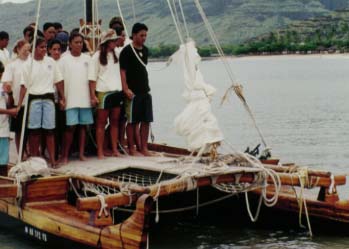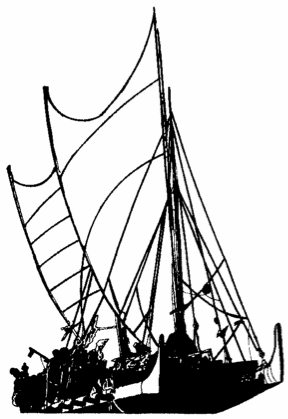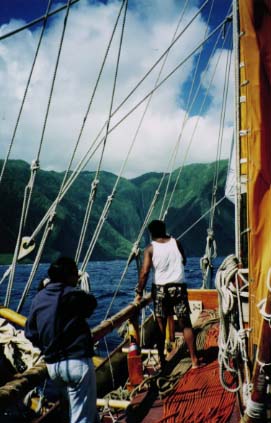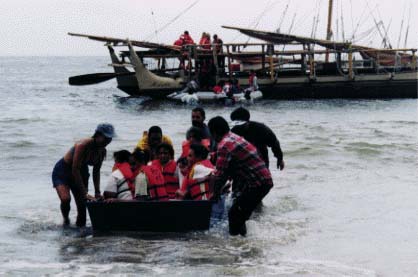PVS Newsletter / Kau (Dry Season) 1997
Aloha, Wrighto
On August 18, 1997, at the age of 53, kahuna kalai wa'a Wright Bowman, Jr. passed away during an single-car auto accident on the Big Island. "Wrighto" or "Bo," as he was affectionately known, was one of the master canoe builders of Hawai'i. Tommy Holmes, in his book "The Hawaiian Canoe," noted Wrighto, with Sonny Bradley, "developed and modified tools that have revolutionized canoe building." In addition to carving numerous six-man racing canoes from koa logs, he took on the monumental task of building the 57-foot Hawai'iloa, the first double-hulled voyaging canoe carved from logs in since the time of the Kamehamehas. During this project, designed to help recover and perpetuate canoe-building traditions in Hawai'i he introduced many young people to the art of canoe building, generously sharing his knowledge with anyone who was willing to learn. Hawai'iloa was launched in 1993 and sailed to the Marquesas Islands via Tahiti, and back to Hawai'i, in 1995. The following is a tribute to "Wrighto" by friends Wally and Keali'ipu'aimoku Froiseth.
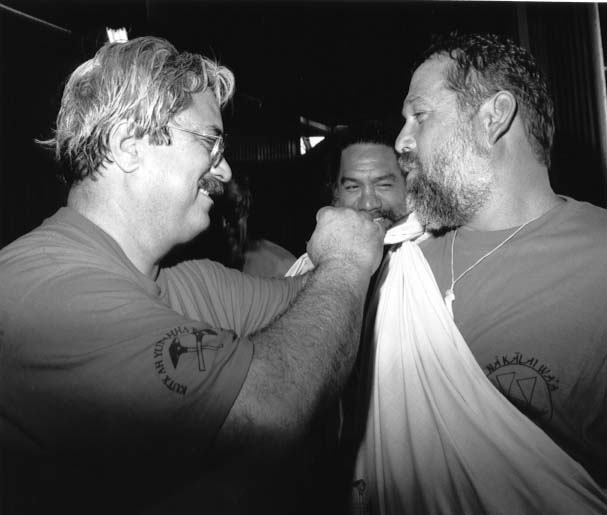
Wrighto with Carlos Andrade, a former Student; Photo by Anne Kapulani Landgraf
Memories and Thoughts of Our Friend Wright Bowman, Jr.
He was a friend to everyone he associated with. "Wrighto," as we called him, loved to create things. He was a master of woodworking and canoe building. He could cut down koa trees, haul the logs, carve the hulls, and do the finishing work.
Working with him showed us he was also a jack of all trades, including welding, rigging, and so on. With the truck he drove for his work at Gaspro, filled with his tools, he could fix just about anything that needed fixing.
One of his greatest atrributes was getting along with people and treating everyone with respect. He was open to everyone and listened to and considered ideas from anyone, no matter who they were.
He was a hard worker and would take on a challenge that most of us would be afraid to start. It was a joy to work with him because he was a doer, not a talker, and a true leader. Everyone who ever worked with Wrighto came away feeling they had helped and contributed something to his projects.
After the day's work was done and time to relax came, we all have fond memories of talking with Wrighto about ideas or plans for the next job or another project.
His positive attitude, energy, and enthusiasm motivated others to want to work with him and be a part of his projects.
Emotion wells up in us just thinking of all the enjoyment, satisfaction, and accomplishments we have known from our association with Wrighto. He inspired many of the young men and women who came down to the canoe to help and learn.
Wrighto, our thoughts will always be with you. We are thankful to have known you and are better because of it.
Joining Islands: 1996-97 Statewide Voyage
Statewide Sail: Hokule'a Anchored Off Kaluapapa, 1997
In ancient times the demi-god Maui tried to pull together the islands of Hawai'i to make them one big island. When his brothers disobeyed his command not to look back, the islands broke free and drifted apart.
From Sept. 23, 1996, to July 19, 1997, Hokule'a brought the islands together again, in spirit. It visited all the islands of the chain, except Ni'ihau. The ten-month sail covered two-thousand miles. Community response to the Statewide Sail was overwhelming--during the 10 month voyage, more than 30,000 school children and community members from 30 different communities participated by working to support or touring the canoe. Community people from each island were trained as crew members, and with great excitement helped to sail the canoe to their home islands. Each community organized activities for the canoe's visit that reflected their own unique interests and special character. Every community greeted Hokule'a and her crew as family and cared for them with great pride. Mahalo nui loa to all who helped make the statewide voyage a success.
Canoe Coordinators were Dennis Chun, Kaua'i; Nainoa Thompson and Bruce Blankenfeld, O'ahu; Penny Martin and Mel Pa'oa, Moloka'i; Clay Bertelmann, Moku o Hawai'i; JoAnne and Leon Sterling, Maui; and Sol Kaho'ohalahala, Lana'i.
Hokule'a on the North Side of Moloka'i 1997
Hokule'a Landing at Hana, Maui, 1997, Photo by Monte Costa
The voyage was conducted by the Polynesian Voyaging Society, the Queen's Health Systems, the Bishop Museum, and the Hawai'i Maritime Center.
Shantell Ching, PVS, and Community Volunteers Ferrying Students Out to Hokule'a at Kahana Bay, 1997
John Koa, Kamaki Worthington, Nainoa Thompson, Richard Spillner, Ian Thompson off Makua, O'ahu, 199
Hokule'a is currently in dry dock near Pier 60 on Sand Island. Volunteers are welcomed to help work on the canoe. Call the PVS office for more information.
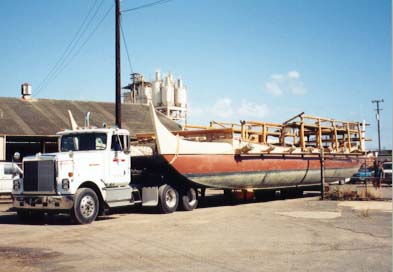
Hokule'a goes into drydock near Pier 60, 1997
Project Ho'olokahi: Inspired Learning
In the Spring 1997, the Polynesian Voyaging Society completed the third year of a project funded by the Hawai'i Community Foundation to develop an ocean education program with the Department of Education. Project Ho'olokahi aims to integrate cultural and environmental learning on land and at sea and to bring students, family, and community together around the shared value of Malama Hawai'i;caring for our special island home. The program culminates with a voyage around O'ahu on Eala,a canoe owned by the Wai'anae Hawaiian Civic Club.
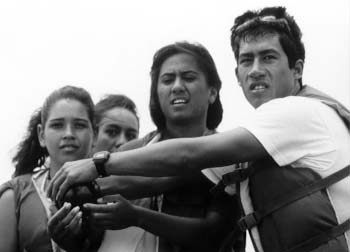
Wai'anae Students Steering Eala. Photo by Monte Costa
Students were asked, anonymously, "Did you Benefit from Project Ho'olokahi? If so, How?"
Student 1: Yes, I did benefit from this program very much! It taught me a lot about who I am and how important it is to know about my ancestors and what my heritage is all about. The most lasting effect that I'll have is the time spent on the E'ala and making that sail from Kualoa to Kahana. It was very awesome! What I will take with me in the future is the importance of the aina (land) that we live on, and how we Hawaiians are nothing without it. And how ohana (family) is important. Mostly how to perpetuate our heritage in language and our everyday lives. And especially learning about how the first Hawaiians used the stars to navigate.
Student 2: I learned so much about the stars, the tides, preparation of the canoe, plotting routes, chants, and a whole bunch of arts and crafts. This program gave me a chance to meet new people and it taught me to have a greater respect and appreciation for everything. I think the part of the program that will have the lasting effect on me is the actual sail and everything that I was taught. The sail because it was a once in a life time thing and it was simply amazing. It gave me a chance to better my social and communication skills with my crew (team). All the information that I learned will also have a lasting effect on me because it was so interesting. Till this day, I still go outside at night and review the stars. I think I could take a lot of these skills with me in my future. Things like communication skills, respect, team working abilities and many more. This program has even encouraged me to possibly study this in college.
Student 3: I think the entire program had a lasting effect on me. I believe that I benefited from the entire program. It has given me cultural awareness. It has taught me what growing up in the Hawaiian way and being Hawaiian was and is all about. It has given me direction in my life and has taught me how to focus on a goal and follow it through, by making sail plans and actually getting to our destinations. It has taught me about effective decision making and weighing out all my options before committing to a decision. This is my second year in the program and I feel that it has helped me to decide what course of study I am going to take in college. I have decided to take up Marine Biology. Being in this program has taught me a lot about how the ocean swells and currents work. It has also taught me how important our oceans are to us and our future. I will take with me the decision making skills, knowledge of the ocean and stars, the cultural awareness and most of all the wonderful memories the program has given me.
